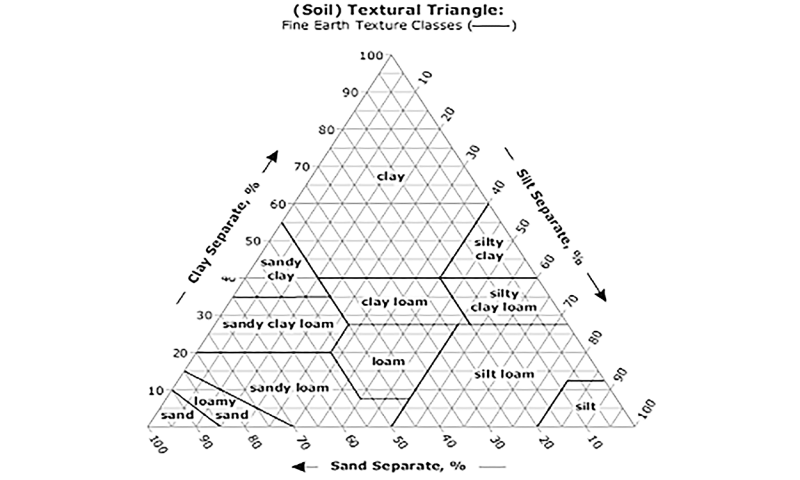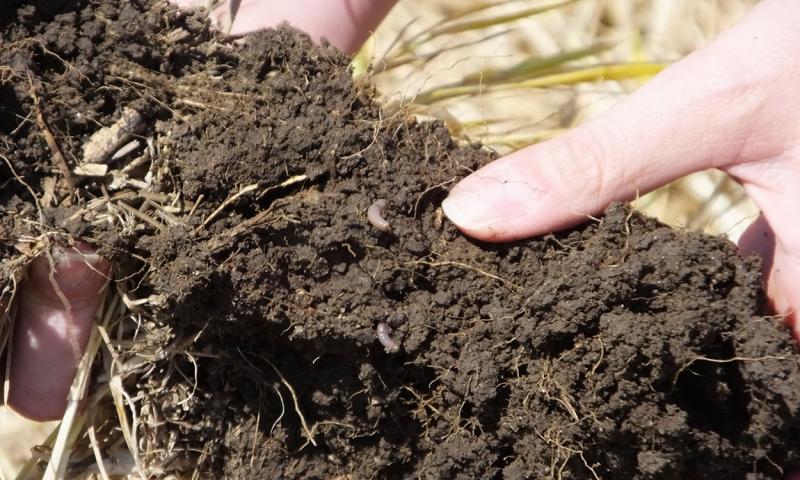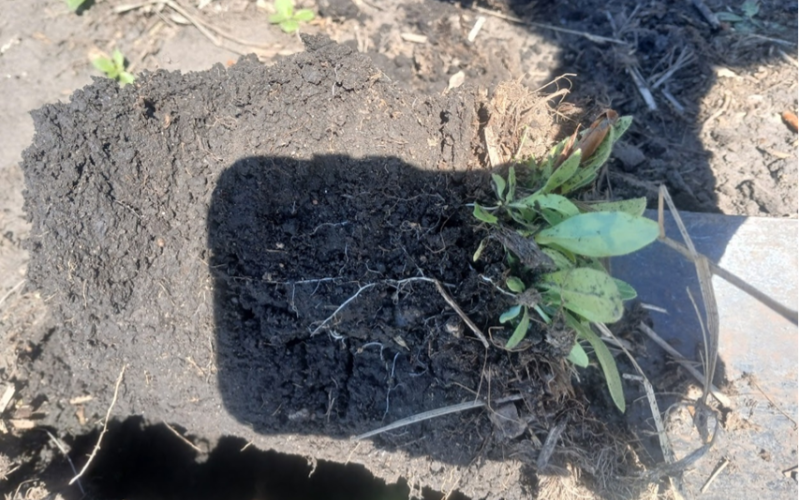Soil consists of particles derived from rocks (geologic minerals), pore spaces containing water and air, both living and dead organic materials, and chemicals dissolved in water, all bound to soil particles and in a solid form. Healthy soil has good soil structure, can cycle nutrients, can filter and retain water, is easily penetrated by plant roots, has a variety of organisms living in it, has adequate plant residues protecting surface, and consistently grows crops and or native vegetation.
Soil Texture

The soil at any location is formed through geologic time from rocks deposited at the location. The soil texture is formed due to soil-forming factors at the location and cannot be easily changed by management. The soil particle sizes are sand (0.0021 to 0.078 inches), silt (0.000079 to 0.0021 inches) and clay (less than 0.000079 inches) and measured at different quantities in the soil determine the soil texture. The soil textural triangle in Figure 1 shows how differing amounts of sand, silt and clay determine texture. It is commonly said that an ideal soil is 50% pore space (water + air), 5 % organic matter, and 45% minerals. The 45% of the soil that is minerals is the sand, silt, and clay component. Organic matter and soil minerals form organized units, which are referred to as soil aggregates. A healthy soil will contain a variety of soil aggregate sizes ranging from small (0.0021 to 0.01 inches) to large (greater than 0.079 inches), which remain together when the soil is wetted and when the soil is dry. Having a variety of pore sizes present in the soil allows rain and irrigation waters to infiltrate, but also lets it store water and chemicals in the small pores within soil structural units.
Organic Matter
The organic matter components of soil can be easily changed by management. Practices that land managers choose can either return or remove organic matter (carbon) to the soil. The amount and type of soil carbon will affect what types of organisms and materials make up the soil organic matter. Organic matter in the soil consists of dead aboveground plant material that has been moved into the soil, living and dead plant roots, soil organisms, sugars, carbohydrates, fats, lignin, cellulose, and humic and fulvic acids. A healthy soil should have a balance of these different types of organic materials. Humic and fulvic acids are types of soil organic matter that are most commonly associated with soil clays and remain in the soil for a long period, whereas particulate organic matter from biology growing in the soil can be rapidly changed. Some carbon compounds, such as sugars, carbohydrates, fats, lignin, and cellulose, are formed through primary production and biologic activity.
Common Organisms

Common organisms in the soil include bacteria, fungi, actinomycetes, protozoa, nematodes, worms, insects, amphibians, reptiles, and mammals. A gram of surface soil (0.035 ounces) can contain approximately 100,000,000 bacteria, 10,000,000 actinomycetes, 10000 protozoa, and 10 to 100 nematodes (Brady and Weil 1999). A cubic yard of soil can contain up to 1,000 earthworms and 1,000 other fauna, consisting of insects, amphibians, reptiles, and mammals (Brady and Weil 1999). These organisms all play a role in soil functioning. Bacteria, fungi, and protozoa help to decompose organic materials and make the nutrients contained in dead soil organic matter available to plants. Certain fungi also create associations with plant roots to help them take up nutrients. Nematodes and protozoa eat other soil organisms and release broken down forms of these organic compounds as plant available nutrients. Worms create pores in the soil; eat organic matter, such as plant residues; and help to decompose these materials. Larger organisms (such as insects, amphibians, reptiles, and mammals) use the soil as a home, create large pores, and mix soil materials.
Soil Carbon

The ideal percentage of soil organic matter and carbon contained in soil compounds is not known. Estimates have shown that 2 to 5% of the soil organic matter is microbial biomass. Some studies have found that about 50 to 90% of the organic matter in the soil is mineral-associated organic matter that will remain in the soil for a long period of time (Simonsson et al., 2014; Cai et al., 2016; Giannetta et al., 2024). However, more analysis is needed to show what fraction of the total soil organic carbon is mineral-associated soil carbon across soil health management practices. Healthy soils have carbon (reactive carbon) that is actively changing and includes soil microorganisms and plant materials in various stages of decomposition. Permanganate oxidizable carbon and particulate organic matter carbon are laboratory procedures that can measure this pool of reactive carbon in the soil. The fraction of the soil that is permanganate oxidizable carbon is about 10 percent of the total soil carbon, whereas particulate organic matter carbon can be up to 10 percent of the total soil carbon but can also be as little as a couple percent (Sharma et al., 2014; Cai et al., 2016; Giannetta et al., 2024). Crop rotation and residue management may more rapidly affect the amount of particulate organic matter carbon and reactive carbon than total soil organic carbon. Removing crop residues or planting low-residue crops, such as soybeans, multiple years in a row may cause the soil to have a lower fraction of reactive or particulate organic matter carbon and a greater fraction of the soil will be mineral-associated carbon. Also, growing crops that produce high carbon-to-nitrogen residues many years in a row can lead to a high fraction of the soil carbon being particulate organic matter carbon. Having too much high carbon: nitrogen particulate organic matter, or having low amounts of carbon from crop residues being returned to the soil annually, does not make the soil ecosystem healthy. Soil microorganisms prefer an intermediate carbon: nitrogen ratio and do not efficiently process high carbon: nitrogen ratio food sources into carbon compounds that can become mineral-associated carbon with soil clays. Having a cropping system that has crops with a range of carbon: nitrogen ratios and leaving residue in the field provides a food source for soil organisms, which can convert particulate organic carbon into stabilized organic carbon associated with soil clays.
In Summary
Healthy soil has strong soil structure that stays together whether it’s wet or dry. A healthy soil allows water to infiltrate, but also has small pores that can retain water within structural units. Healthy soil has an abundant biologic community, ranging from microorganisms, such as bacteria and fungi, to macro-organisms, such as insects and worms. Healthy soils have adequate cover on the surface from both dead and growing plants. Healthy soils can efficiently release nutrients that are essential for plants, but also keep these nutrients near the soil surface for plants and organisms to use in the future.
References
- Brady, N.C. & Weil, R.R. 1999. The nature and properties of soils 12th ed.. Prentice-Hall Inc. Upper Saddle River, New Jersey.
- Cai, A., Feng, W., Zhang, W., & Xu, M. (2016). Climate, soil texture, and soil types affect the contributions of fine-fraction-stabilized carbon to total soil organic carbon in different land uses across China. Journal of environmental management, 172, 2-9.
- Giannetta, B., Plaza, C., Galluzzi, G., Benavente-Ferraces, I., García-Gil, J. C., Panettieri, M., ... & Zaccone, C. (2024). Distribution of soil organic carbon between particulate and mineral-associated fractions as affected by biochar and its co-application with other amendments. Agriculture, Ecosystems & Environment, 360, 108777.
- Sharma, V., Hussain, S., Sharma, K. R., & Arya, V. M. (2014). Labile carbon pools and soil organic carbon stocks in the foothill Himalayas under different land use systems. Geoderma, 232, 81-87.
- Simonsson, M., Kirchmann, H., Magid, J., & Kätterer, T. (2014). Can particulate organic matter reveal emerging changes in soil organic carbon?. Soil Science Society of America Journal, 78(4), 1279-1290.


